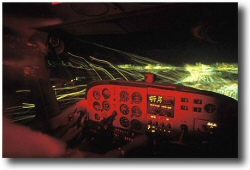Night flying: Sort through the different definitions of night

With the days getting shorter, many pilots will be doing more of their flying at night, making this the perfect time to get all of the night flying regulations straight.
Night: "The time between the end of evening civil twilight and the beginning of morning civil twilight, as published in the American Air Almanac, converted to local time." That's the FAA's definition in FAR 1.1, but it's only one of many ways night is described in the Federal Aviation Regulations.
When logging night flying time for private or commercial certification, follow the definition in FAR 1.1.
If you need to get night current to carry passengers, follow the definition of night as described in FAR 61.57(b), which is the "period beginning one hour after sunset and ending one hour before sunrise." Remember, to get night current you will need to make three takeoffs and landings to a full stop in an aircraft of the same category, class, and type. More information about night operations is available through the AOPA Air Safety Foundation's Safety Hot Spot: Flying Night VFR.
If you're trying to figure out when you need to turn on your position and anticollision lights, check out FAR 91.209. According to this definition of night, you will need to turn on those lights "during the period from sunset to sunrise." However, the pilot in command can turn off the anticollision lights "in the interest of safety." For example, if you are waiting to take the runway and someone is on final, it might be best to turn off the anticollision lights to avoid affecting the other pilot's night vision.
November 10, 2005


